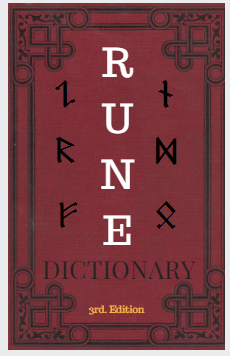Rune Dictionary
By Venita Wessex
An introduction to the interpretation and usage of Germanic runes.
Last Updated
May 31, 2021
Chapters
16
Reads
55427
Chapter 8: Hagall’s Anglo-Saxon Aett
Chapter 10
ᚻ ᚺ Hagalaz --- Hægl Phonetic value: /h/, as in the English high, the French hotte, and the Spanish ojo Meaning: Hail Changes: None, apart from those noted in the introduction to this chapter. General Overview: A note of use to transcriptions surrounding Hagalaz versus Hægl is that, while both can either be written with a single or double barred line connecting the two lines of the “H,” it is more common to see the single line as part of the Elder Futhark and the double bar as part of the Anglo-Saxon Futhorc. ᚾ Naudhiz --- Nied Phonetic value: /n/, as in the English month, the French connexion, and the Spanish cantar Meaning: Necessity / Trouble Changes: None, apart from those noted in the introduction to this chapter. Magical Uses: As noted earlier when discussing Thorn, it is hypothesized that it might be useful in sacrificial magic like its parent rune, but this is usually dismissed by scholarly sources as conjecture. ᛁ Isa --- Is Phonetic value: /i/, as in the English east and free, the French fini, and the Spanish tipo Meaning: Ice Changes: None, apart from those noted in the introduction to this chapter. ᛄ ᚼ Jera --- Gear or Ger Phonetic value: /j/, as in the English you and yes, the French yeaux, and the Spanish ayer Meaning: Year Changes: The shape of Jera changed significantly when it transitioned to become Gear. The meaning as compared to its parent rune is similar -- year as compared to harvest -- but not quite the same. General Notes: You may be confused to see the letter “j” equated with words “you” and “yes” but this is not an error. These are the actual sound values ascribed to Gear or Ger. You will often see both the letters “j” and “y” attributed to this rune because of this. In writing, both may be substituted. ᛇ Eihwaz --- Ēoh Phonetic value: [eo], as in the English Romeo and stereo Meaning: Yew tree Changes: Potentially the sound has changed from the original, but because Eihwaz’s phonetic value was so contested, it is difficult to be sure. At the very least, this script has finally settled on one sound. General Notes: Note that “Galleon” and “gorgeous” do not contain the same “eo” sound as outlined above. While some people use this rune in that manner for letter-for-letter transcriptions, when attempting a completely phonetic transcriptions, this is incorrect. ᛈ Perthro --- Peorth Phonetic value: /p/, as in the English Patronus, the French pomme, and the Spanish peso Meaning: Unsure: potentially fruit-tree or chessman Changes: The meanings changed from the original dice cup and womb to “fruit tree,” or potentially chessman. General Notes: Due to the cryptic nature of the Anglo-Saxon Rune Poem, it is unclear as to what the meaning of this rune actually is. The two mentioned above are the most likely suspects. Additionally, it is interesting to note that the potential meaning of “chessman” is slightly linked with the original meaning of “dice cup,” as both are objects used in forms of games or entertainment. A final note on the meaning of “chessman”: this meaning of “chessman” might be better understood simply as “game,” as chessman is a reference to a specific category of games. While it is impossible to know for sure which game this might be, a handful of scholars put forth the ancient game of Hnefatafl, a game enjoyed by every class of person in the time when the Anglo-Saxon Futhorc was in use. ᛉ Algiz --- Eolh Phonetic value: [ks], which those who speak English think of as “x”, as in the English six Meaning: Elk-sedge Changes: The phonetic value shifted from /z/ as in magizoologist to a “ks” sound. Magical Uses: While the rune itself has no magical claim to fame, its namesake certainly does. Elk-sedge, or Cladium mariscus is an herb native to Europe and Asia that, according to some manuscripts uncovered, was a main ingredient in a troublesome poison which caused internal bleeding. General Notes: In addition to its magical uses, elk-sedge’s most common use was in thatching, bedding for animals, and occasionally as floor covering. ᛋ Sowilo --- Sigel Phonetic value: /s/, as in the English serpent, the French façade, and the Spanish saltador Meaning: Sun Changes: The shape of this rune altered slightly. General Notes: While it does not stand for the sound /z/ as in magizoology, Siegel can also be used to transcribe the letter “z” as s and z were pairs that were undifferentiated at the time the script was in use. This is similar to the “double duty” that Fehu and Feoh serve.


